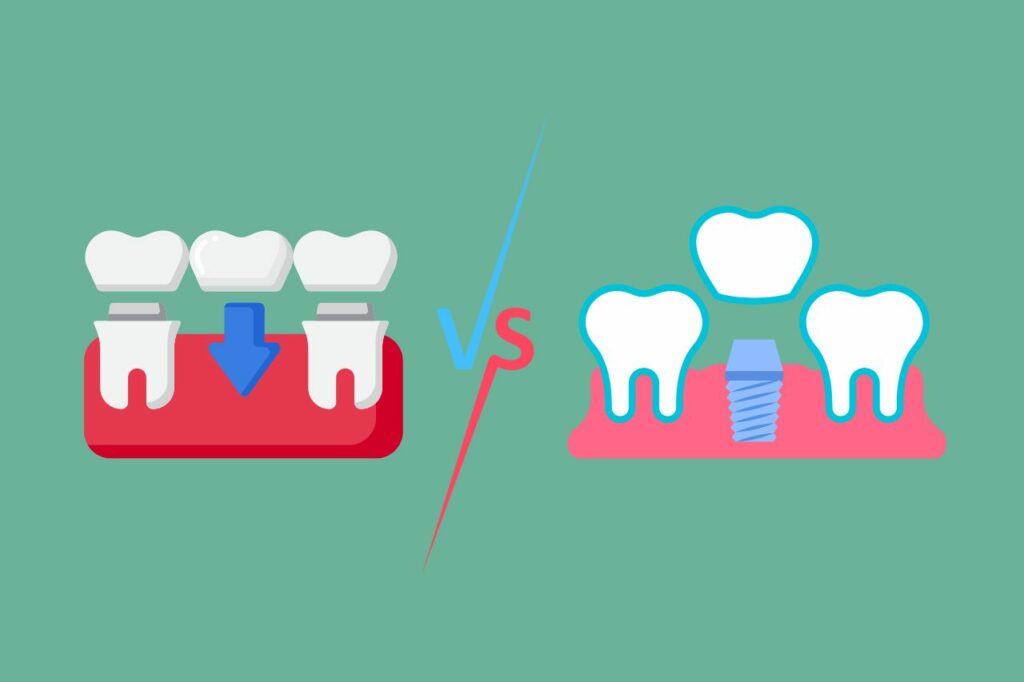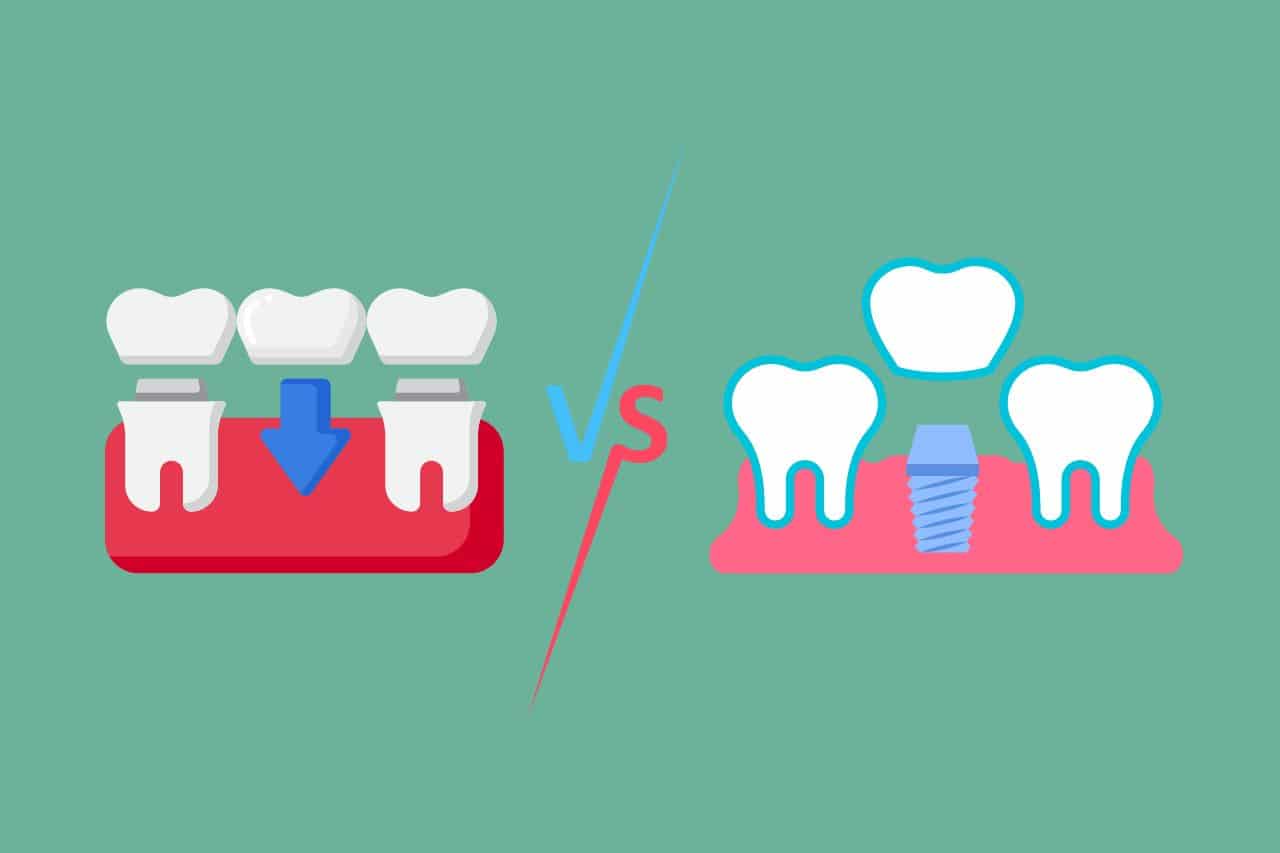Dental Bridge Vs Implant: Which Option Is Best For You?
Tooth loss is a serious problem, affecting millions of people worldwide. Up to 69% of adults aged 35 to 44 have lost at least one adult tooth, and by age 74, roughly 25% of Americans have lost all of their adult teeth. Losing a tooth not only impacts your smile but can also lead to difficulties with eating and speaking, making it essential to find a proper replacement to maintain oral function and appearance.
When considering tooth replacement options, two common choices are dental bridges and implants. Both options offer unique benefits and can restore your smile and oral function effectively. However, each option works differently and may be more suitable for certain patients, depending on their individual needs and oral health. Read all about the differences and benefits of a dental bridge vs implant.
In This Article:
- Dental Bridges: What are they, and how do they work?
- Dental Implants: what are they and how do they work?
- Comparison of Dental Bridge vs Implant:
- How do you decide between dental bridge vs implant?
- Dental bridge vs implant: talk to your dentist
Dental Bridges: What are they, and how do they work?
A dental bridge is a dental appliance that bridges the gap caused by one or more missing teeth. Dental bridges work for one or several missing teeth and can restore your smile and chewing ability.
The bridge typically consists of one or more artificial teeth, also known as pontics. A dental bridge is a fixed dental appliance that is used to replace one or more missing teeth by attaching a false tooth to the remaining teeth on either side of the gap. The procedure involves placing crowns on the adjacent teeth to support the pontic. Typically, they’re made of plastic or porcelain, to match the natural look and color of your teeth. Dental bridges are custom-made to fit your mouth.

The process of getting a dental bridge usually involves several appointments with your dentist. Of course, the dentist will start by examining your mouth and sometimes take X-rays.
● At the first appointment, your dentist will prepare the adjacent teeth, sometimes by filing them down, to make room for the crowns.
● We will then take impressions of your teeth to create a custom bridge that fits exactly in your mouth.
● In the meantime, your dentist may place a temporary bridge to protect your teeth and gums.
● At the final appointment, we will remove the temporary bridge and place the custom bridge in your mouth, securing it with dental cement.
Dental bridges can provide various benefits, including improving your ability to chew and speak, preventing your remaining teeth from shifting out of place and restoring the appearance of your smile.
There are also some limitations. For example, they may need to be replaced every 5 to 15 years, depending on the quality of the materials used and your oral health.
Dental Implants: what are they and how do they work?
If you’re looking for a more permanent solution to replace missing teeth, dental implants might be a good option for you. A dental implant is an artificial tooth root that’s placed into your jawbone to support a replacement permanent tooth or bridge.
The implant itself is usually a titanium screw. It’s topped with a replacement tooth, also known as a crown. Because the implant is embedded in your jawbone, it creates a strong foundation and becomes nearly invisible.

The process of getting a dental implant typically involves several appointments with your dentist or oral surgeon.
● At the first appointment, your dentist will assess your oral health and checks the jawbone to determine whether you’re a good candidate for the procedure.
● If you’re a candidate, we will then place the implant into your jawbone, under local anesthesia. After the implant is placed, you’ll need to wait a few months for it to fuse with your bone.
● Once the implant has fused with your bone, your dentist will attach an abutment, a small connector that holds your replacement tooth or bridge in place.
● Finally, we will place your custom-made replacement tooth or bridge onto the abutment, creating a natural look and beautiful smile.
Dental implants offer advantages over other tooth replacement options, such as dental bridges. For example, they provide a more permanent solution. With proper care, they can last a lifetime. They also don’t require the support of adjacent teeth. Dental implants also help to preserve your jawbone and prevent bone loss, which can occur when teeth are missing.
However, dental implants also have some limitations. For example, they can be more expensive than other options, and the process of getting an implant can take several months to complete. Additionally, not everyone is a good candidate for dental implants, particularly those with significant bone loss in the jaw.
Do you have a broken tooth? Our blog ‘Dental Veneers vs. Implants: Which Treatment is Right for You?’ may interest you.
Comparison of Dental Bridge vs Implant:
Dental bridges and implants both offer a solution to the same problem. However, they are different solutions, each with pros and cons.

Dental Bridges
Pros:
● Dental bridges are typically covered by insurance.
● Unlike implants, bridges do not require bone grafting or invasive surgery.
● The cost of dental bridges is usually lower than that of dental implants.
● Bridges usually require only two visits to your dentist over a couple of weeks. It is not a complicated procedure.
Cons:
● Dental bridges have to be replaced every 5 to 15 years.
● They may be visible, as bridges are not embedded in the jaw.
● The natural-looking appearance of bridges diminishes with age.
● Bridges can damage the healthy teeth around the missing tooth when they’re placed (the dentist may need to cut them to fit them) or through decay.
Dental Implants
Pros:
● Dental implants can last 15 years or more and are the longest-lasting tooth replacement option.
● Implants retain a natural-looking appearance because it’s embedded inside your jaw.
● Implants function like a ‘real tooth’, so it doesn’t damage surrounding teeth.
● Dental implants have a very high 10-year success rate.
Cons:
● Dental implants are less likely to be covered by insurance.
● The cost of dental implants is usually higher than that of dental bridges.
● The process of getting dental implants can take up to 6 months because there is more healing time before the final crown can be placed.
● Not everyone is a candidate: the jaw bone needs to be able to hold the implants.
● The procedure of getting dental implants is a procedure that could lead to surgical complications.
● The body may reject the implant (for example in patients with uncontrolled diabetes, but other infections can occur).
● Not generally suited for (growing) children and adolescents.
Additional differences between dental bridge vs implant:
● Visibility – dental bridges may be slightly visible behind or in between replacement teeth, while implants are not visible.
● Existing teeth – bridges often require the filing of the adjacent natural teeth for support, while implants do not.
● Wear over time – dental bridges can weaken over time due to pressure and the filing of supporting teeth, while implants can last as long as natural teeth.
● Jaw health – dental implants prevent bone loss and preserve jaw health, while bridges do not.
How do you decide between dental bridge vs implant?
Of course, each set of teeth and individual situation is different. That’s why your dentist at Mint Dental will do their best to lay out your options, so you can make a well-informed decision. Factors to include are for example:
Cost
While dental bridges typically have a lower upfront cost, they may need to be replaced more frequently, which can add up in the long term. Dental implants have a higher upfront cost but are a more long-lasting option.
The health of surrounding teeth
If the surrounding teeth are healthy and strong, a dental bridge may be a good option, since it relies on these teeth for support. However, if the surrounding teeth have existing issues or decay, a dental implant may be a better choice as it does not rely on these teeth for support.
Bone density
Dental implants require a certain amount of healthy jawbone for successful placement. If the bone density is inadequate, a bone graft may be necessary before an implant is placed. A dental bridge does not require the same level of bone density as an implant.
Personal preferences
Some people may prefer the convenience of a dental bridge, as it is usually completed in fewer dental visits. Others may prefer the durability and more natural appearance of a dental implant.
Age and overall health
Age and overall health can also play a role in determining which option is best. Dental implants are recommended for adults with fully developed jaws, typically after the age of 18 or 21. It is a medical procedure, which comes with a bit of risk. If there is a health risk, dental bridges are the safer option.
Dental bridge vs implant: talk to your dentist
Even though it seems like a challenging decision, you are not alone. The staff at Mint Dental will guide you through this process. We will not hesitate to give you our professional advice. Make an appointment now to discuss your options.

